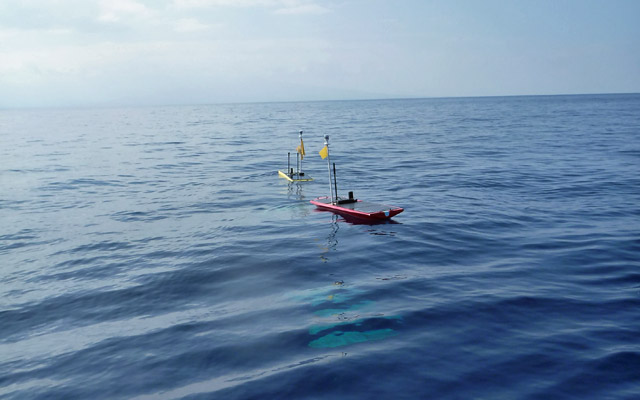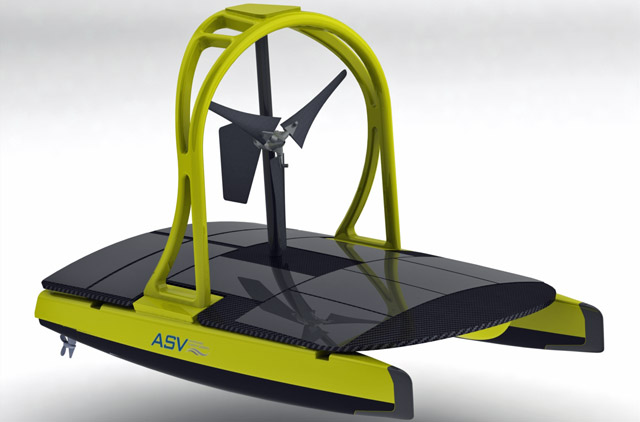The unmanned maritime market has seen a lot of movement in the past few months, with new vehicle announcements, upgrades to past systems and transitions of popular platforms to new companies.
Although past systems have proven themselves with record-breaking swims across the globe and impressive manoeuvring skills that aid in their endurance, the theme remains that companies are honing in on making their platforms even more adept at staying in the water for as long as possible.
SURFACE VESSELS FACE UP
Liquid Robotics this spring released a new version of its Wave Glider, the Wave Glider SV3, which features amped-up power and communications capabilities and built-in scalability.
The SV3 - SV stands for surface vehicle - is 2ft larger than the company's original 7ft Wave Glider, now called the SV2, and boasts an upgraded software architecture called Regulus. The cloud-based platform enables inter-vehicle communication and allows customers to do in-situ processing of high-resolution acoustic or radio-frequency information, among other things.
 |
|---|
|
"It's just a maturation, the next stage in evolution for long-duration autonomous vehicles and long-duration autonomous data collection in the ocean," says Bill Vass, CEO of Liquid Robotics, in an interview with AUVSI.
Unlike the SV2, the SV3 has a hybrid propulsion system that can use wave power, thrusters or solar power, enabling it to operate in higher current areas, although its predecessor vehicle can claim hurricane wave experience. (While Vass says it's possible SV3 could also survive a hurricane, the company is unable to test for it at its Hawaii facility, which has consistent inch-high to 7ft waves in different areas.)
The company's endurance goal is to allow long-duration missions without intervention in the ocean, a feat proven by the SV2's record-breaking Pacific crossing, from California to Japan and then Australia. Liquid Robotics approaches this by making as many of the Wave Glider's components redundant as possible. The real limit on Wave Glider missions, says Vass, is the age-old ocean problem of biofouling.
The system has a significant jump in speed as well, according to Vass. In addition to an auxiliary thruster, the SV3 has one more solar panel on board than the SV2.
Vass says he envisions clients will still use the SV2 for grid applications, where you want to deploy fleets at a lower cost or for research purposes. The SV3 has about twice the towing ability of the previous Wave Glider for very large instruments, which may be attractive to the oil and gas sector, and added security layers, which could attract government. The two systems could also be used in conjunction, he said, with the SV3 acting as a relay for SV2 data.
The new system is the beginning of the company's "floating data centre at sea" concept, he says.
"This really in many cases about knots and watts. It's increasing speed, increasing power, increasing payload and increasing compute," says Vass.
This new product is the first in what may become a family of systems for Liquid Robotics.
"There will probably be an extended line beyond that, as well, in the future," says Vass.
In other new surface vessel news, UK-based ASV of Porchester and MOST (AV) of Chichester have been selected to work on the next generation of a long-endurance unmanned surface vehicle. The two companies were chosen in a competitive downselect to participate in the second phase of the contract. Judges from the Marine Autonomous and Robotic Systems facility at the National Oceanography Centre in Southampton selected the companies from a total of five that participated in the first phase.
 |
|---|
ASV |
ASV's C-Enduro and MOST's Autonaut vehicles will compete in the next phase of the contract, which aims to gather scientific data from the ocean for an extended period of time through the use of sensors, satellite navigation tools, data transfer to the shore, and communications for command and control.
"Long-endurance marine unmanned surface vehicles will make a major contribution to the ability of scientists to take measurements from the ocean, which are currently grossly under-sampled in space and time," says Geraint West, the head of national marine facilities at the National Oceanography Centre. "The process that selected MOST (AV) and ASV was very rigorous, and we are confident that we have two excellent partners to take this exciting program forward."
CHANGES TO AUV
Endurance challenges are the same for underwater vehicles. Teledyne Webb Research announced in July a new version of the company's Slocum line of autonomous underwater vehicles that aims to lengthen its time in the water.
The new Slocum G2 glider is a hybrid, which lets it have better underwater flight efficiency, says the company. Teledyne Webb Research changed its basic configuration from past models to include the hybrid feature. For customers who purchased a previous version of the glider without the hybrid feature, the company is offering a retrofit with a new thruster using a collapsible propeller that folds under when the glider is in buoyancy-only mode.
The unmanned underwater vehicle market also saw a major revival of a UUV that had lost its sea legs.
Kongsberg Underwater Technology announced that it has secured the rights to sell the Seaglider autonomous underwater vehicle.
The Kongsberg Maritime subsidiary negotiated for the rights with the University of Washington, the original creators of the Seaglider. The AUV recently fell out of the marketplace when iRobot dissolved its maritime division in late 2012. The company offered to keep up support for its current customers but ended all sales of the product, which it had the licence to produce since 2008.
"We are extremely pleased to add Seaglider technology to Kongsberg's market-leading AUV product line," says Tom Healy, president of Kongsberg Underwater Technology. "Seaglider will allow us to further expand into new segments of the marine technology market. It fits very well with our philosophy of providing comprehensive, full-picture solutions to our customers."
The move consolidates many popular AUVs under Kongsberg Maritime's umbrella. The company also sells the Hugin and the REMUS, which is under the subsidiary Hydroid.
Source: Flight Daily News























